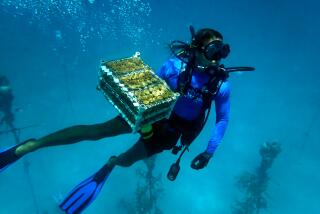Seashell Collectors Walk the Beach of Isle Haven Doing ‘Sanibel Stoop’
- Share via
SANIBEL ISLAND, Fla. — All along the dazzling white sand beaches embracing this 14-mile-long, 2-mile-wide southwest Florida island, men and women, boys and girls are bent over picking up seashells.
From dawn to dusk, all one sees dotting the beaches are derrieres. They call it the “Sanibel stoop.”
This island is a mecca for seashell collectors, the seashell capital of America.
Sanibel and Captiva, its 5-mile-long, half-mile-wide neighbor, which are connected by a short bridge, are said to boast the greatest numbers and varieties of seashells anywhere in the nation.
Ponce de Leon, Florida’s discoverer, is said to be the first non-Indian to set foot on the two islands, when in 1513 he was searching for the Fountain of Youth.
Spanish mariners who sailed to these shores in the 16th and 17th centuries called Sanibel and Captiva the Costa de Caracoles-- the coast of seashells.
Legend has it that Sanibel is named after Santa Isabelle, queen of Spain, and Captiva, for being the place where pirates imprisoned their captives.
Sanibel, 20 miles southwest of Ft. Myers on the Gulf Coast, is connected to the mainland by a 3-mile causeway.
Every spring, the “Tiffany of seashell shows”--the four-day Sanibel Shell Fair--is held at the Sanibel Community Center on Periwinkle Drive, a thoroughfare named, of course, after a seashell.
Thousands of shellers from all over the world come to the Sanibel Shell Fair.
“It’s the oldest shell fair in the U.S. so far as we know,” explains Dot Putnam, 69, a fair director since 1972. The first Sanibel Shell Fair, as we know it today, was held in 1937.
But its roots go way back.
R. Tucker Abbott, in his book “Kingdom of the Sea Shell,” has this to say about Sanibel: “Shell shows are an American innovation, begun informally in Florida at the turn of the century when enthusiastic shellers on Sanibel Island displayed their spoils on long tables set up on the veranda of the Island Inn.”
Abbott is founding director of the Shell Museum and Educational Foundation. The group has launched a $1.25-million campaign to put up America’s only seashell museum on an eight-acre site on Sanibel Island. Construction is scheduled to begin shortly.
At this year’s seashell fair, visitors encountered an array of aquariums at the entrance. It was the traditional “Live Shell Exhibit” by 23 fifth-graders from Sanibel Elementary School.
“These are egg cases of lightning whelks,” explained Jenny Grondi, 10, pulling a long string of tan snail egg cases from her tank.
Marty Traucht, 11, pointed to two seashells in his aquarium and said: “These are two live angel wings.”
Angie Sicca, 10, leaned over her aquarium declaring: “This is the common five-arm sea star, what most people call a starfish, only it isn’t a fish.”
And so it went, as the fifth-graders explained sea life.
Teachers Mary McHarg and Alice Anders introduce the youngsters to local seashells and shore life throughout the school year. The boys and girls impart knowledge learned to shell fair visitors.
Tiny coquinas, conch shells, clam shells, alphabet cones, tulips, paper figs, horse conch, kings crown, fighting conch, sea anemones, feather worms, sea slugs, lace murex and nippy dogfish--all gathered from local shores--thrive in the tanks.
So did a rare Junonia or Juno, Sanibel’s most celebrated and sought-after shell. When anyone finds a Junonia, a ship’s bell is rung on the island to tell of the exciting discovery.
It happens several times each year.
Proceeds from the shell fair are used to maintain Sanibel Community Center. Islanders donate thousands of shells for sale under the big Shell Tent.
Art Ford, 80, and his wife of 57 years, Kay, 77, spend months teaching and working with islanders who hand-craft shell animals contributed for sale.
Professional shellers from around the world, such as Yasuji Ando of Japan with his Japanese miniatures, exhibit collections at the show. Trophies are awarded for outstanding scientific collections, and prizes go for shell creations including paintings, necklaces, flowers and figures.
The shell fair is sponsored by the 410-member Sanibel-Captiva Shell Club and the Sanibel Community Assn.
More to Read
Sign up for The Wild
We’ll help you find the best places to hike, bike and run, as well as the perfect silent spots for meditation and yoga.
You may occasionally receive promotional content from the Los Angeles Times.






